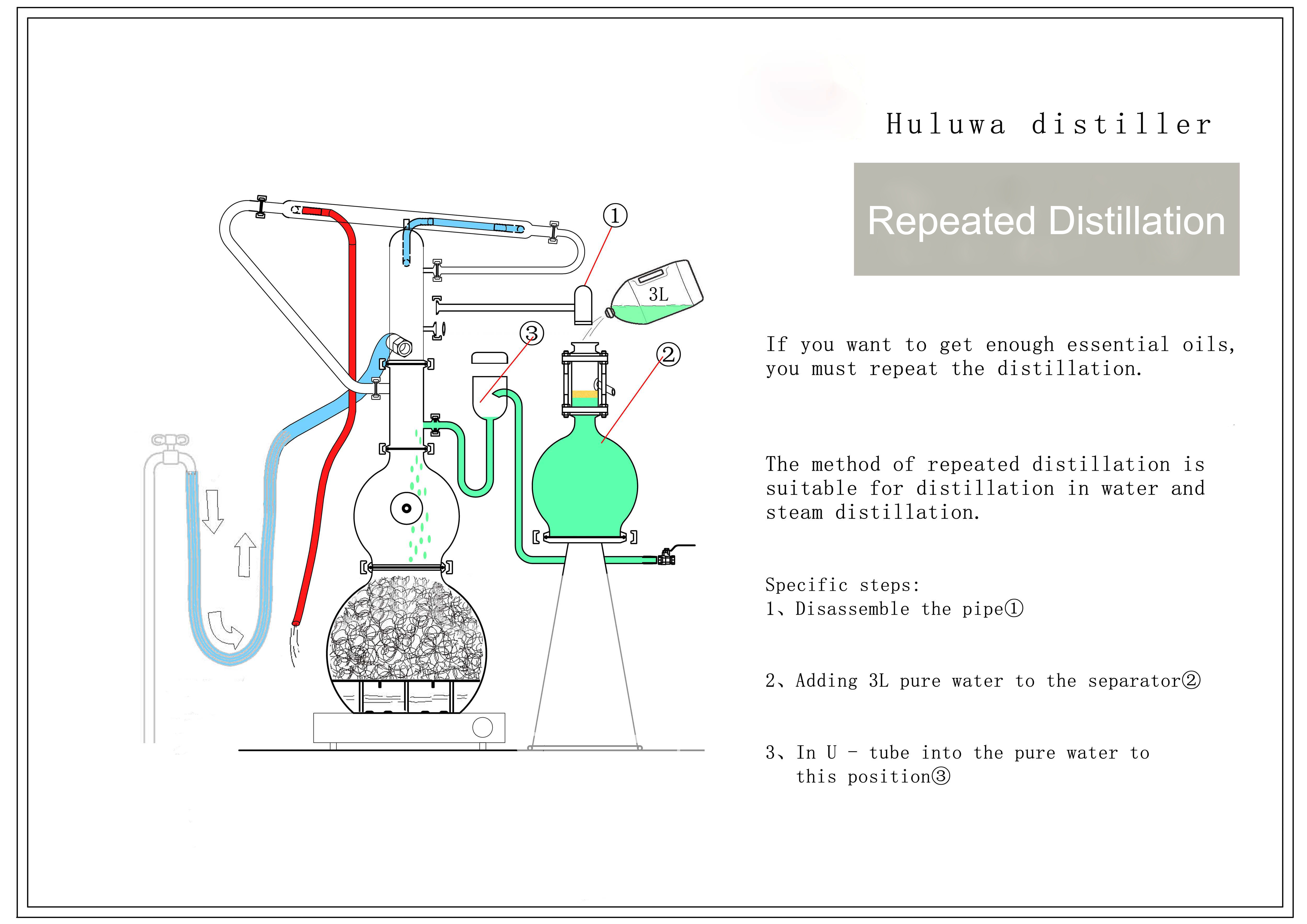1. Distillation:
Distillation is one of the earliest methods to extract aromatic essential oils from the plant world. With the evolution of different ages, distillation equipment has been significantly improved a lot. This refining method is very convenient, that is, boiling the raw materials together with water, or using steam to refine. Nowadays, distillation has become the most commonly used method for refining essential oils.
Put the fresh or dried plant material into the steam heating furnace, heat it from below and send in the steam to evaporate the essential oil in the plant and turn it into a water vapor state containing the essential oil, and then pass it through the duct of the freezing box After the collection and cooling, the water vapor will condense into a liquid state due to cooling, and then separate the essential oil according to the difference in the specific gravity and density of the water and the essential oil, and the remaining liquid is collected by the collector. In these liquids, some essential oils are more or less soluble in them, which is the so-called pure dew.
Geranium, Lavender, Carrotundefined Seed), Chamomile (Chamomile), Eucalyptus, etc. are all refined using this method.


2. Enfleurage:
The aroma method is the oldest method for extracting aromatic essential oils in Southern France (Grasse), and it is also the most expensive method of extraction due to the large amount of manpower and time spent.
The principle is to use the physical properties of grease to absorb oil agents to refine aromatic essential oils. The selected fat has to be specially treated to prevent it from going bad. The aroma absorption method uses cold fat. Generally, the fats used contain ingredients such as lard and tallow.
The method is: add a glass basin on the bottom of the wooden frame, apply a layer of lukewarm fat on the bottom of the basin, but leave the edge of the glass basin without being coated with grease (this can absorb the fragrance The saturated oil of the essence is used when it swells, and then spread a layer of fresh petals that have just been picked on the greased area. Coat the bottom surface of several glass basins with grease and put petals, and then layer the glass basins like tiles one by one, so that the petals are between the upper and lower layers of the glass with grease, and the grease absorbs the petals. Essence. After allowing the petals to stay in the oil layer for about 16-72 hours (the time depends on different flower species, usually it can be replaced every day), then another batch of petals will be replaced. Repeat this step until the grease layer is fully saturated-when the grease layer expands to the edge of the glass, it is saturated. The entire procedure usually takes three months. Finally, it is treated with alcohol and stirred with a machine. After the alcohol evaporates, what is left is the aromatic essential oil.
Jasmine, Rose, Neroli, etc. in aromatic essential oils are refined by this method.
3. Maceration:
The soaking method is usually used to extract the aromatic essential oils in resins, gums and petals. This extraction method is similar to the aroma method, but uses liquid oil instead of the creamy oil in the aroma method, and it is also time-saving compared to the aroma method.
First put petals or resin into a container that has been filled with liquid grease, heat the container to raise the temperature of the grease to between 60°C and 70°C, and keep it at this temperature. When petals or resins are immersed in this liquid oil, plant cells and tissues will work slowly after being heated-split, and the essential oils in the plant will be decomposed, and these aromatic essence components will be absorbed by the liquid oil. Due to the different specific gravity, the saturated grease can be extracted by filtration after cooling.
Frankincense, Myrrh, Sandalwood, etc. in aromatic essential oils are refined by this method.
4. Expression:
This method is mostly used to extract citrus aromatic essential oils. It is the most traditional and economical household production method for preserving citrus essences. Because essential oils are mostly contained in these peels, first chop and squeeze the peel so that the juice in the peel is squeezed out and penetrated into the sponge, and then squeezed to make the juice flow out, and then collected.
The Expression method is the traditional technology of ordinary household production in the past. In recent years, machines have replaced manual squeezing: Put the fruit into a container with long nails on the inner wall, and roll the entire container. The fruit will be pierced by the long nails around to make the juice It flows into another collection container, where the essential oil is separated by a centrifuge. This method is faster, time-saving and hygienic than the traditional method of manually squeezing the juice out.
Lemon, Orange, Bergamot, Lime and Grapefruit in aromatic essential oils are all extracted by pressing.
5. Dissolving:
Use alcohol, ether liquid butane… and other solvents, repeatedly pour it on the plants to be extracted, and then slowly heat it with electric heating to extract the essential oils in the raw materials from the solution, and then stir and cool the solvent containing the essential oils with alcohol , Separation and analysis, and essential oil can be obtained by low-temperature distillation. This is the latest extraction method, which can be used to replace the fragrance extraction method undefined
